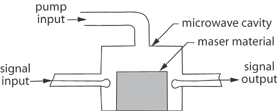A maser (microwave amplification by stimulated emission of radiation) is a device that produces coherent electromagnetic radiation in the microwave frequency range. It is the microwave analog of a laser, which operates in the optical frequency range.

Stimulated emission: Like a laser, a maser operates based on the principle of stimulated emission, where atoms or molecules in a suitable medium are stimulated to emit coherent radiation by an external electromagnetic field. This coherent emission results in the amplification of microwave radiation.
Microwave frequencies: Masers produce coherent radiation in the microwave frequency range, typically spanning from about 1 gigahertz (GHz) to hundreds of gigahertz. This makes them suitable for various applications in telecommunications, radar, spectroscopy, and radio astronomy.
Active medium: The active medium in a maser can consist of various materials, such as certain types of gases (e.g., ammonia), solids (e.g., ruby crystals), or artificial systems (e.g., superconducting quantum circuits). These materials are chosen for their ability to support stimulated emission at microwave frequencies.
Applications: Precision timing and frequency standards in atomic clocks. Communication systems, including satellite communications and wireless networks. Radar systems for remote sensing, surveillance, and navigation. Spectroscopy techniques for studying molecular and atomic transitions. Radio astronomy observations, including studies of cosmic microwave background radiation and interstellar molecules.
The development of masers in the mid-20th century paved the way for the subsequent development of lasers and other coherent radiation sources. While lasers have found widespread use in various applications, masers continue to be essential tools in specific fields requiring coherent microwave radiation. They remain an active area of research for improving performance, miniaturization, and exploring new applications in emerging technologies.